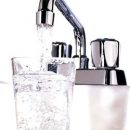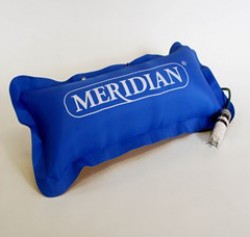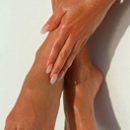Features and advantages of using an irrigator
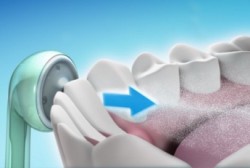
The principle of action of such a device is that it forms a thin, but a fairly powerful water stream, which is able to remove pollution even in the most hard-to-reach corners of the oral cavity.
The irrigator is recommended to use as an additional tooth cleaning agent, but in some cases it can completely replace the usual brush. MyMedinform.COM found out how the device under consideration has:
- Unlike a toothbrush, the irrigator acts much softer, which is especially important for people with sensitive, prone to bleeding gums. However, the elastic jet of water, submitted under pressure, can perfectly cope with pollution. Using an irrigator in a complex with a brush, you cut the contact time of rigid bristles with the surface of the teeth and gums.
- Power fluid during the device can be adjusted by selecting the most appropriate option. Among other things, many irrigators allow you to use special settings designed for teeth processing, language or gum.
- Included with the irrigator for sale various nozzles, each of which is designed to perform certain functions.
Indications for using the device
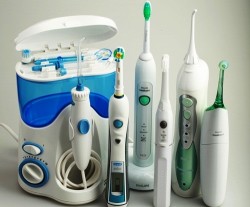
All irrigators by way of use are customary to divide into two large groups. Consider them in detail:
- Stationary devices are designed for home use. Such irrigators differ quite large sizes and good power, as well as a wide choice of nozzles. Stationary type irrigators can be attached to the wall, and the possibility of changing the nozzle allows you to use the device to all family members. The devices of this type have a spacious water reservoir, the volume of which is 0.5-1 l, but in the process of work such irrigaters are quite noisy.
- Portable irrigators are characterized by smaller sizes and power, but you can always take with you on a trip or on a business trip. Such devices do not need to be connected to the network, and operate on batteries or batteries. Although the power of portable irrigate is somewhat less than that of stationary, it is quite enough for efficient and high-quality oral care. Compact sizes of technology do not allow it to be equipped with a large number of nozzles, which can be attributed to the disadvantages. The capacity of the reservoir in such devices is from 140 to 210 ml - this is not enough for the family, but it is enough for one person.
It is difficult to say which of these types of irrigate is better, because both options differ in its intended purpose. Those who are often in the roadway, it is more expedient to purchase a portable device in case of travel, and stationary - for home use.
Irrigators are also classified according to the features of the jet, depending on this indicator distinguish such types of equipment:
- Irrigators with monosites are considered an outdated form of instruments and have low efficiency. In the process of operation, such irrigaters form a thin continuous stream of water, beating with the same pressure.
- Devices with a pulsating stream are considered a more efficient tooth cleaning agent. In the process of operation, water pressure is supplied with different intensity, which occurs a small ripple. Microhydraulic blows help carefully remove flare and food residues from teeth and gums.
- Microbubble irrigators today are the most effective devices. In the process of their use in the oral cavity, water jet comes saturated with small air bubbles. Such irrigators have a bactericidal effect, since they can remove bacteria from periodontal pockets.
The choice of irrigator: what else to pay attention to
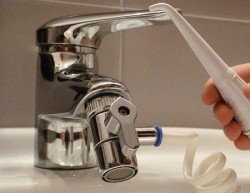
Choosing an irrigator, you should pay attention to its complete set. Some models are equipped with only one or two nozzles, others have a variety of devices for cleaning the language, periodontal pockets, prostheses, implants, and T. NS. Decide before purchase, in which the device will be subsequently used. If you do not wear braces or dentures, special nozzles can not need you, but the nozzle for cleaning the language is needed almost everyone.
If the technique will use several people, it is desirable that the irrigator has an individual nozzle for everyone. Many manufacturers label such nozzles with different colors, so that family members are not confused subsequently. Included with the device can also be sold to a device for Nose washing. The nozzle of this type is a fairly useful invention, because from a runny nose periodically suffers.
The ability to regulate the intensity of the jet - another important characteristic of the device. For example, children and people with sensitive gums are recommended to use the stream of weak pressure. The same regime is suitable for those who only recently began to brush their teeth by the irrigator. Well, those people who use the device for quite a long time and do not have inflammation in the oral cavity, can establish a strengthess for themselves with a strong pressure.
Popular models of irrigator
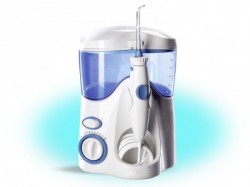
To date, you can find many different models of irrigator for the oral cavity, consider the characteristics of several popular options presented in the Russian market:
- DONFEEL OR-820M irrigator is a Russian production. The average price for this model is about 5000 rubles, but the cost may differ depending on which nozzles are included in the device. Standard set includes 4 nozzles, but there are models that are equipped with a special device for washing the nose. The irrigator has 4 modes of operation, the principle of water supply - microbubble.
- Irrigator B.WELL WI-911 is a Chinese model with an average cost of 3200 rubles. Standard configuration of the device includes 2 nozzles, charger and instruction manual. The device works from the battery, the charge of which is enough for about half an hour of use. This irrigator belongs to portable devices, has a small tank capacity of 135 ml, functions in 3 modes, and water is supplied as a pulsating jet.
- Waterpik WP-100 Ultra irrigator is produced in the USA and costs about 10,000 rubles. Complete set of goods includes 7 nozzles, water reservoir for this model is quite voluminous, with a capacity of 650 ml. The model works in 10 different modes and is distinguished by low noise. All nozzles can be stored in a special compartment.
- The Aquajet LD-A7 irrigator is produced in Taiwan and costs about 3300 rubles. The model has 4 modes of operation and 4 inkjet nozzles, has a very high power, the maximum value of which reaches 810 kPa. The irrigator has a volumetric tank with a capacity of 500 ml, water jet is supplied in ripple mode.
The range of irrigate in the modern market is quite wide, we have described only a few most common models. Choosing a suitable option, focus not only for the cost, but also on the functionality of the device and whether a specific model is suitable for your features and requests.

